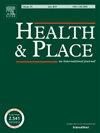Exploring socio-ecological factors that influence the use of urban greenspace: A case study of a deprived ethnically diverse community in the UK.
IF 3.8
2区 医学
Q1 PUBLIC, ENVIRONMENTAL & OCCUPATIONAL HEALTH
引用次数: 0
Abstract
Urban greenspaces are considered an important health asset associated with improved population health and well-being. However, inequalities in access to and use of the outdoors continue to exist, particularly among low-income and minority ethnic populations. Following a socio-ecological approach, this study aimed to investigate the individual, interpersonal, and environmental factors that influence the use of greenspaces among an ethnically diverse community in the UK and explore strategies to increase use. A mixed-methods cross-sectional community survey was conducted between March and June 2022 with residents of two ethnically diverse towns situated in Southeast England, UK. Data were collected on factors that influence greenspace use alongside demographic information on age, ethnicity, and social deprivation. An open-ended question explored respondents’ views on strategies to increase engagement with greenspaces. The survey was completed by 906 participants aged between 16 and 94 (60.7% female; 94.5% non-white British). The findings revealed that age, gender, perceived importance of using greenspaces, awareness of greenspaces, and the natural environment were all significant predictors of greenspace use. Qualitative evidence supported these findings and provided useful strategies for increasing access. The findings have provided an increased understanding of the factors that influence greenspace use and suggest that to improve access. There is a clear need to improve the quality of the available green spaces, making them safe and visually appealing to the local communities they serve. Increasing awareness and providing more opportunities for social and intergenerational interaction were also considered important strategies for increasing use.
探索影响城市绿地使用的社会生态因素:英国一个贫困的种族多元化社区案例研究。
城市绿地被认为是与改善人口健康和福祉相关的重要健康资产。然而,在获取和使用户外活动方面仍然存在不平等现象,尤其是在低收入人群和少数民族人群中。本研究采用社会生态学方法,旨在调查影响英国一个种族多元化社区使用绿地的个人、人际和环境因素,并探索提高使用率的策略。2022 年 3 月至 6 月期间,对英国英格兰东南部两个种族多元化城镇的居民进行了一次混合方法横断面社区调查。除年龄、种族和社会贫困程度等人口统计学信息外,还收集了有关影响绿地使用的因素的数据。一个开放式问题探讨了受访者对提高绿地参与度的策略的看法。906 名年龄在 16 岁至 94 岁之间的参与者(60.7% 为女性;94.5% 为非英国白人)完成了调查。调查结果显示,年龄、性别、认为使用绿地的重要性、对绿地的认识以及自然环境都是预测绿地使用情况的重要因素。定性证据支持了这些研究结果,并为提高使用率提供了有用的策略。研究结果加深了人们对影响绿地使用的因素的理解,并提出了提高绿地使用率的建议。显然需要提高现有绿地的质量,使其安全并在视觉上吸引当地社区。提高人们对绿地的认识,提供更多社交和代际互动的机会,也被认为是提高绿地使用率的重要策略。
本文章由计算机程序翻译,如有差异,请以英文原文为准。
求助全文
约1分钟内获得全文
求助全文
来源期刊

Health & Place
PUBLIC, ENVIRONMENTAL & OCCUPATIONAL HEALTH-
CiteScore
7.70
自引率
6.20%
发文量
176
审稿时长
29 days
期刊介绍:
he journal is an interdisciplinary journal dedicated to the study of all aspects of health and health care in which place or location matters.
 求助内容:
求助内容: 应助结果提醒方式:
应助结果提醒方式:


